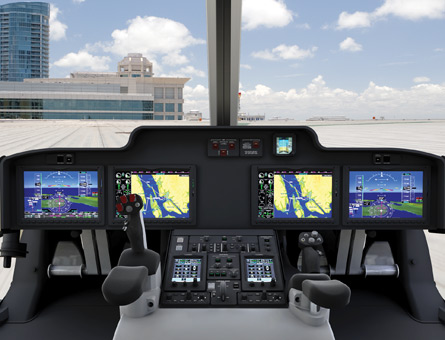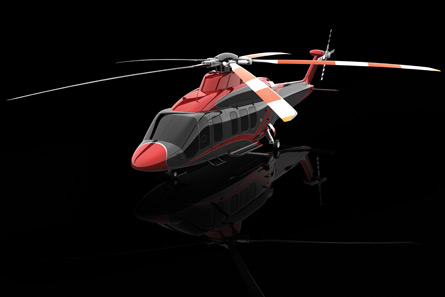Bell Helicopter has started technology risk reduction work for the 525R "Relentless" super-medium twin helicopter at its XworX rapid prototyping centre near Dallas, while officials at the company's fellow Texan production facility in Amarillo work on assembly line planning.
Both facilities will play a key role in Bell's plan to shake up the super-medium twin helicopter (7-8t) category with the 525R in the mid-decade timeframe.
 |
|---|
| © Bell Helicopter Fly-by-wire systems will use tactical cueing to enhance safety |
Along with best-in-class performance and "lowest cost per seat mile" in the sector, the 525R is targeting a 500nm (925km) range, indicated by the second "5" in the 525R name. The first "5" in the name stands for a five-bladed main rotor, and the "2" represents the fact it is twin-engined. Bell chief executive John Garrison said the company's employees came up with the "Relentless" name as well as the logo for the product line.
PROJECTED RANGE
Garrison and Larry Roberts, Bell's senior vice-president for commercial business, provided details on the programme at XworX on 15 February; three days after Garrison unveiled the 525R to much fanfare at the Heli-Expo show in Dallas.
Garrison said there was a "constant flow of people" around the mock-up at the show, a percentage of them "serious buyers". "People were saying, it's great to see Bell back [with a new product]," said Garrison.
While Bell did not clarify specific conditions associated with the projected 500nm range, it is generally held that a 400nm range is best-in-class for the super-medium twin helicopter, based on typical performance numbers for the two competitors in the sector, Eurocopter's EC175, set for entry into service (EIS) this year, and AgustaWestland's AW189, slated for EIS in 2014.
After unveiling the 525R at Heli-Expo, Bell would only reveal that range would be "more than" 400nm. No price or delivery dates were set, only that first flight is likely to be in 2014.
XworX, based at Arlington Municipal airport near Dallas, will work with Bell's technology centres of excellence on the key technologies behind the 525R, including blades, drive train, transmissions, integrated vehicle health and management (IVHM), fly-by-wire (FBW) systems and integrated cockpit.
Company officials said the 525R will carry Bell's first five-bladed rotor system, its first in-production fully articulated rotor head, and the industry's first forward-fit FBW system for a commercial helicopter.
Bell's previous FBW experience is considerable, including the V-22 and BA609. Despite the ability to move away from traditional controls with FBW, Roberts said the chief pilots on Bell's customer advisory panel (CAP) wanted a cyclic and collective control device with each pilot "feeling" the others' control inputs, which Bell said will be handled via a hybrid-mechanical link between the controls.
BAE Systems, which provides triply-redundant FBW technology, has built "active inceptor" feedback systems for the military, systems that in addition to providing a customised feel for the position of flight controls, can be used for envelope protection cues. Roberts said the 525R FBW system will use tactical cueing to alert pilots to limits, for instance by using a stick shaker, but will allow them to fly past the limits.
 |
|---|
| © Bell Helicopter |
The 525R will be powered by two GE Aviation CT7-2F1 turboshaft engines down-rated to 1,800shp (1,300kW) each, "matched" to the drive train and main rotor disk for maximum efficiency, said Roberts. In addition to its normal function, the IVHM will be a "central core and part of the aircraft", he added. "Diagnostics and prognostics are designed into the aircraft rather than being an aftermarket fit," he said, allowing "significant expansion of service life" and time-before-overhauls, contributing to the promised "lowest cost per seat mile".
Along with engineers, XworX's 46 touch-labour technicians and 25 support staff are trained to provide "back-of-napkin to build" projects using 36 machines, including 22 computer numerical control devices, said Greg Ready, Bell's manager of experimental manufacturing and operations at XworX. The division's helicopter flight department includes a Bell 214ST being used for 525R transmission risk reduction testing, a Bell 427, 407AH, 407GX and a Bell 430 avionics testbed.
POWERED LIFT
In the powered lift arena, XworX uses a V-22 Osprey engine nacelle for advanced development work as well as a fully functional V-22 leased from the US Marine Corps. The aircraft, one of the earlier models delivered, is undergoing its four-year maintenance check and will be used for advanced tiltrotor technology testing when it resumes flying. An AW609 (formerly the BA609) also sits in the hangar as part of Bell's contractual arrangement to help AgustaWestland gain US Federal Aviation Administration certification for the civil tiltrotor.
In the unmanned sector, XworX is also constructing several more optionally manned MQ-8C Fire-X helicopters - based on the 407 - under contract to Northrop Grumman as unmanned cargo delivery test aircraft for the US Navy. The first Fire-X had its initial flight in December 2010.
Bell's Arlington facility is also equipped to flight test as many as three aircraft simultaneously in restricted airspace near the site, and more aircraft remotely using portable telemetry systems.
Bell is testing the OH-58 block II Kiowa Warrior upgrade for the US Army, the Fire-X, the armed Bell 407AH, and the Garmin-equipped 407GX in Arlington. Telemetry from the flight-test aircraft is transmitted on two frequencies to capture data at all aircraft attitudes and once brought into the flight-test data system, it is sent via private network to an interactive analysis and display system for test conductors and engineers on site or at remote locations.
ASSEMBLY CENTRE
Also at Amarillo, where 1,256 employees manufacture military aircraft including the V-22 Osprey tiltrotor, UH-1Y Venom and AH-1Z Viper, officials are planning a 525R assembly line along one side of the 1,500ft-long (460m) building. Given that V-22 production is scheduled to slim down from a peak of 40 in 2013, existing facilities should be adequate, said Mike Scruggs, vice-president of Bell's Amarillo assembly centre.
 |
|---|
| © Bell Helicopter The Amarillo plant manufactures a number of military rotorcraft, including the Bell Boeing V-22 Osprey tiltrotor |
Scruggs said Bell will work on 525R tooling for the plant during 2012. Construction of the 525R will be metal and composites, with airframe composites targeted for areas that have caused corrosion problems for operators. "Through the CAP, we found that operators spend up to one-third of their operational budgets dealing with corrosion," said Garrison. He added that some of the 525R cabin work may be transferred to company facilities in Chihuahua, Mexico in the future.
Bell has no airframe partners in the programme but Garrison said that might change depending on the outcome of "detailed discussions". Although unveiled with a nominal 16-seat cabin, Bell said it is also working on a 20-passenger high-density version.
Garrison said engineers have been designing the 525R for 16 months, and have already conducted a series of windtunnel tests at the University of Texas. When asked whether the helicopter was closer to preliminary design review level or critical design level, Garrison hinted at the latter. "It's a detailed mock-up for a reason," he said.
Source: Flight International



















